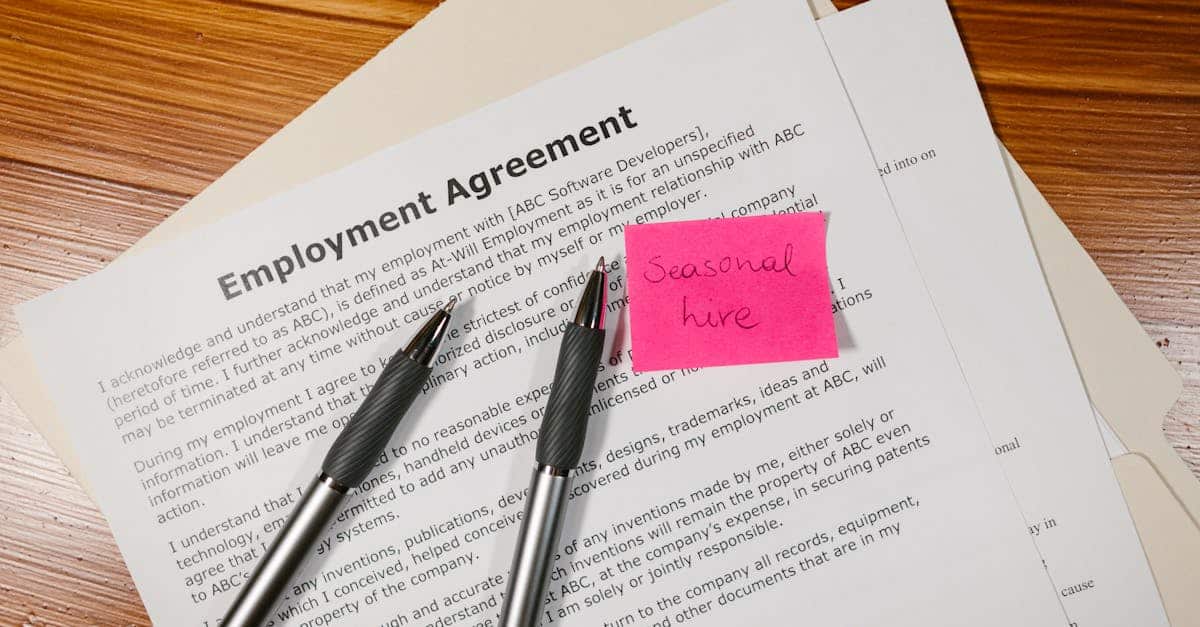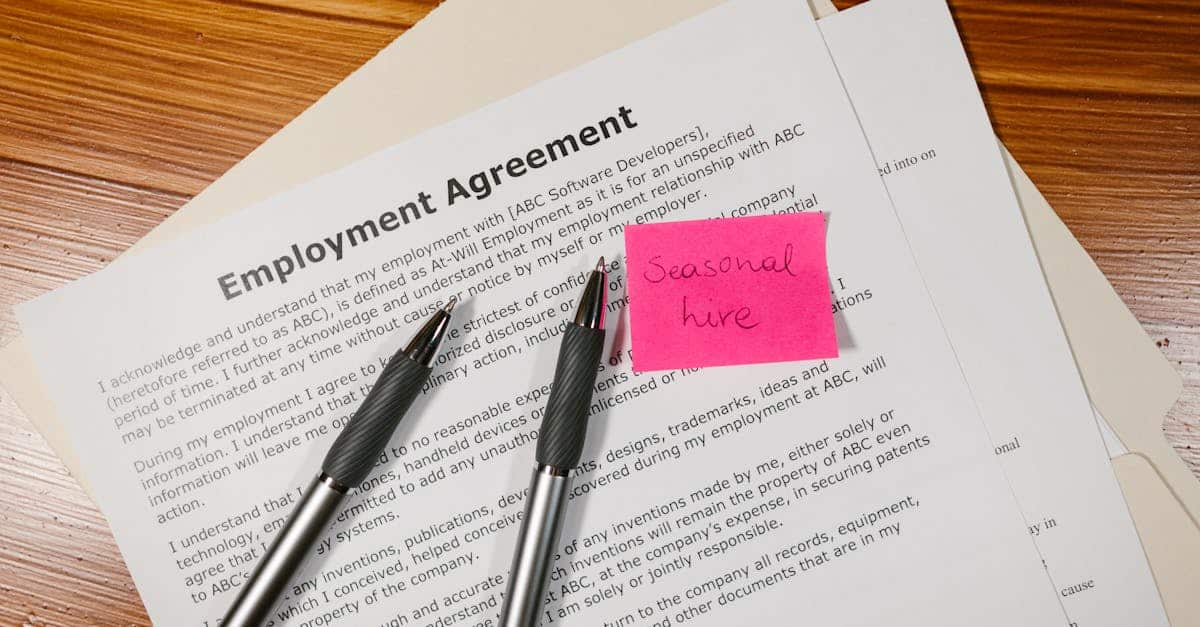
Introduction
Hiring moves fast but signatures don’t. Every offer letter, NDA and policy acknowledgement can become a manual bottleneck — filling fields, chasing countersigns, and reconciling executed documents into your HRIS — which slows onboarding and raises compliance risk. No‑code e‑signature automation lets HR teams build and iterate offer, NDA and policy workflows without waiting on developers, so offers go out quickly, signers complete on time, and records land where they belong.
This guide walks through the practical steps your team needs: choosing connectors that fit your stack, designing reusable templates, mapping sequential and parallel signing flows, meeting I‑9/HIPAA and audit‑trail requirements, automating reminders/countersigns/archival, and measuring adoption. You’ll see how to balance no‑code convenience with extensibility (API/SDK options) and apply clear patterns for templates, multi‑signer flows, compliance and automation. From choosing the right connectors for e-signature integration to tracking signature completion and time‑to‑sign, the sections below give HR, legal and compliance teams a step‑by‑step path to reduce manual work and risk.
Selecting no‑code tools and e‑signature connectors that integrate with HR systems
Choose the right balance between no‑code convenience and integration needs. No‑code e-signature platforms and ready-made e-signature connectors (Zapier, native HRIS plugins) let HR teams get started quickly without developers. However, if you need deep automation or custom identity checks, pair no‑code tooling with an e-signature API or SDK.
Checklist for selecting tools
-
Prebuilt HR integrations: Look for connectors to your HRIS, ATS, payroll and document stores (Salesforce, Workday, BambooHR).
-
Connector options: Evaluate Zapier and native connectors for common flows — e-signature integration Zapier vs built‑in integrations to reduce maintenance.
-
Platform extensibility: If you expect custom routing, ID verification, or CLM later, confirm availability of an e-signature API or SDK for developers.
-
Security & compliance: Check SOC2, ISO 27001, HIPAA options and audit‑trail features.
-
UX for signers: Mobile friendliness, inline signing, and localized language support.
For commerce platforms and marketing stacks, verify specific integration paths like e-signature integration Salesforce, e-signature integration HubSpot, or e-signature integration WordPress so your HR forms and public offer pages work smoothly.
Template design for HR: offer letters, NDAs, policy acknowledgements and conditional fields
Design templates to reduce manual editing and legal risk. Use standardized blocks for common HR documents (offer letters, NDAs, employment agreements) and build conditional fields so a single template serves multiple cases.
Practical template patterns
-
Offer letters: Pre-fill candidate data from your ATS/HRIS, include variable salary/bonus blocks, and a clear acceptance signature block. Example resource for an offer template: https://formtify.app/set/job-offer-letter-74g61.
-
NDAs and policy acknowledgements: Use scope‑specific clauses and mandatory checkboxes for recipients to confirm reading. Store a baseline copy for legal reference — example NDA template: https://formtify.app/set/non-disclosure-agreement-3r65r.
-
Employment & termination documents: Maintain separate templates for full‑time, contractor, and termination scenarios. Keep an editable employment agreement template handy: https://formtify.app/set/employment-agreement-mdok9 and a termination letter template for offboarding triggers: https://formtify.app/set/termination-of-employment-letter-eyvtl.
-
Conditional fields: Use show/hide logic for benefits, visa sponsorship, or commission clauses so signers only see relevant sections.
Best practices: keep signature blocks consistent, add date/time stamps, include signer role labels (candidate, HR rep, manager), and validate fields (email, SSN masked) before routing for signatures. These patterns support clean electronic signature integration and easier audits.
Multi‑signer and sequential signing flows for candidates, managers and legal
Map your signing flows before building them. Clarify who signs, in what order, and which steps can happen in parallel. Simple paths are candidate → HR → hiring manager; complex paths may add legal, finance, or executive approvals.
Flow types and when to use them
-
Sequential signing: Use when approval depends on the previous signer (e.g., candidate signs, then manager reviews).
-
Parallel signing: Use when multiple stakeholders can sign independently to save time (e.g., HR and finance countersign after offer acceptance).
-
Conditional routing: Route to legal only when specific clauses are present or compensation exceeds a threshold.
Implement these flows with either a no‑code e-signature connector or an e-signature API if you need programmatic control. Webhooks and callbacks let your HRIS update status in real time, supporting contract lifecycle management and secure handoffs.
Authentication options: email OTP, SMS codes, or stronger api-based identity verification for high-risk documents. Choose methods commensurate with the document sensitivity and regulatory needs.
Compliance and secure storage: I‑9s, HIPAA considerations and audit trails for HR records
Compliance is a core requirement for HR documents. Make sure your e-signature implementation provides immutable audit trails, secure storage, and configurability for retention and access controls.
I‑9 and federal rules
-
Electronic handling of Form I‑9 is permitted when your vendor meets storage, tamper‑evidence and access requirements; confirm with counsel and your vendor’s documentation.
-
Keep supporting docs and verification steps linked to the form and ensure role‑based access so only authorized staff can view sensitive information.
HIPAA and healthcare data
-
For PHI or health‑related authorizations, require a vendor with HIPAA support and a signed Business Associate Agreement. Example HIPAA form template: https://formtify.app/set/hipaaa-authorization-form-2fvxa.
-
Use encryption at rest and in transit, strict access logging, and retention policies aligned with privacy law.
Audit trails and legal validity
-
Ensure the e-signature solution records signer identity, IP, timestamp, and the document’s hash. These elements support compliance with ESIGN/UETA and local laws.
-
Secure digital authentication and tamper‑proof logs make electronic records defensible in audits or disputes.
When in doubt, consult legal counsel about particular document types and jurisdictions — especially for immigration forms and health data.
Automating reminders, countersigns and archival to HRIS or document stores
Automation reduces manual work and improves turnaround. Set up rules for reminders, countersigning, and archival so documents move through the hiring lifecycle without constant human intervention.
Common automation patterns
-
Reminders: Configure scheduled reminders with escalation after X days. Use personalized messages to reduce friction and increase completion rates.
-
Countersign workflows: Automatically route to finance, legal or managers after the candidate signs. Use conditional branches for approvals requiring senior signers.
-
Archival: Push executed PDFs and metadata to your HRIS, SharePoint, S3, or a document store. Many platforms support automatic indexing and folder placement.
Use no‑code connectors for straightforward triggers, or wire webhooks from an e-signature API for event‑driven workflows. Link archival actions to offboarding flows (for example, attach a signed termination letter: https://formtify.app/set/termination-of-employment-letter-eyvtl) and enforce retention policies programmatically.
Measuring adoption: signature completion rates, time‑to‑sign and reducing manual follow‑ups
Measure what matters and iterate quickly. Track metrics that show how well e-signature processes are performing and where people drop off.
Key metrics to track
-
Signature completion rate: Percentage of sent documents that reach a fully executed state.
-
Time‑to‑sign: Median time from send to final signature; segmented by role (candidate vs manager) to spot bottlenecks.
-
Drop‑off points: Identify where users abandon the flow — at form fields, authentication, or last‑mile acceptance.
How to reduce manual follow‑ups
-
Automate reminders and escalation paths, test different reminder cadences and templates, and use conditional triggers for counter‑signing.
-
Use analytics from your e-signature software integration or pull events with an e-signature API to populate dashboards. Export metrics to your BI tool or HRIS for ongoing reporting.
-
Continuous improvement: Run small experiments (subject lines, button copy, authentication method) and measure impact on completion rate and time‑to‑sign.
Regularly review metrics and align thresholds with SLAs so HR can proactively intervene only when needed, not for every incomplete signature.
Summary
No‑code e‑signature automation gives HR, legal and compliance teams a practical way to remove signature bottlenecks: pick connectors that match your stack, build reusable templates with conditional fields, map multi‑signer flows, enforce audit‑ready compliance, and automate reminders and archival. These patterns reduce manual follow‑ups, shorten time‑to‑sign, and keep executed documents where they belong while preserving extensibility through APIs or SDKs when you need it. By treating security, templates, signing flows and metrics as part of a single program you get reliable, auditable e-signature integration across your HR systems. Ready to streamline offers, NDAs and policy acknowledgements? Start exploring templates and connectors at https://formtify.app.
FAQs
What is e-signature integration?
E-signature integration is the process of connecting an electronic signature service to your existing systems (HRIS, ATS, document stores) so documents can be sent, signed and recorded without manual handoffs. Integrations range from no‑code connectors to deeper API/SDK links that let you prefill data, trigger sign flows, and archive executed PDFs automatically.
How does an e-signature API work?
An e-signature API exposes endpoints to create documents, add signers and fields, send signing requests, and retrieve signed artifacts programmatically. Webhooks and callbacks notify your systems about status changes so you can update records, kick off countersigns, or archive files automatically. APIs also let developers add stronger identity checks or custom routing when no‑code tools aren’t sufficient.
Which e-signature providers support integrations?
Major providers such as DocuSign, Adobe Sign, and Dropbox Sign (HelloSign) offer a mix of native integrations, AppExchange or marketplace connectors, and full APIs/SDKs for custom work. Many platforms also work with no‑code automation tools like Zapier or provide prebuilt HRIS plugins, so you can pick the route that fits your team’s technical resources and compliance needs.
Are e-signatures legally binding?
Yes—e-signatures are generally legally binding in many jurisdictions when they meet basic requirements like signer intent, consent to use electronic records, and an auditable record of the transaction (timestamps, IP, document hashes). Compliance can vary by document type and location, so consult legal counsel for sensitive documents (immigration, wills, certain notarizations) and confirm your vendor’s audit‑trail and identity‑verification features.
How do I integrate e-signatures with Salesforce?
Integrating with Salesforce can be done using native AppExchange packages from major e‑signature vendors, third‑party connectors, or custom API integrations that create records, send envelopes, and write back signed PDFs. For most HR workflows, start with a prebuilt connector or Zapier flow to get value quickly, then consider API/SDK work for deeper CLM or complex routing.





